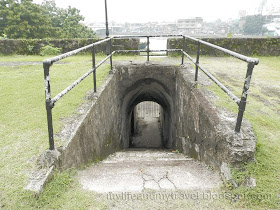My visit to Fort Santiago was full of excitement and enthusiasm. As I entered the gate, my first impression was like I was entering a place from a different era. The first thing I saw at the frontage were horses and carriages, an old tranvia, trellis with vines and a fountain at the center of a small park. There were also a group of young students on their educational tour and a group of tourists.
 |
A replica of the pre-war Manila street cars. |
The park, walkway and picnic areas have changed this fortress into a peaceful and comporting place to spend your vacation or spare time.
Repairs are currently ongoing on the right side of the walls of Fort Santiago and the Rizal Shrine but they are kept clean and safe so that visitors will not feel uncomfortable. The Rizal Shrine inside the fort is a reconstruction of the colonial period barracks where the patriot, Jose Rizal, was confined during his trial for sedition. It is now a museum where reminders of the hero can be viewed.
 |
Rizal Shrine |
At the entrance of the stone wall, I immediately noticed the shoe prints embedded in pavement. I got curious onto whom it belongs and what does it represent. So I followed the trails and see what it leads to.
The trail leads me to an old building with iron bars. Behind the iron bars is a statue of a man whose arms are tied. When I got closer, I learned that it was a statue of Jose Rizal and those trail of shoe prints represents where he passed on his way to Bagumbayan from Fort Santiago and immortalizes his brave path to martyrdom.
From here, I walked to the other part of Fort Santiago, The Baluarte de Sta. Barbara. Named after the patron saint of artillerymen and was built to protect the entrance to the Pasig river. At the side of Baluarte de Santa Barbara are the dungeon and a cross monument. On the cross monument lie the mortal remains of approximately 600 Filipinos. It serves as a memorial to all these unknown victims of the Japanese Imperial forces.
 |
Baluarte de Santa Barbara |
 |
In Memory of the victims at Fort Santiago |
 |
An Entrance to the Pasig River |
 |
Dungeon |
The Dungeon is a restricted area for visitors. I don't know the real reason but I think it's for safety measures. The dungeons used to be the storage vault for powder magazine of the Baluarte de Santa Barbara. Because of dampness caused by the humid weather and the nearness to the Pasig River, the Spaniards decided to built a new powder magazine on top of the baluarte. The vaults were converted into prison cells and storerooms. It must be hard to breath inside that dungeon.
At the top of the stronghold is a view of Pasig River. The Rizaliana Furniture Hall can also be found here.
The Rizaliana Furniture Hall showcases the furniture's used by the Rizal Family. Paintings related to Jose Rizal are also on display.
 |
O Sei San, A woman Jose Rizal fall in love with while in Japan. |
Going out of the Fort, I took the route that leads to Medio Baluarte de San Francisco. This route offers a view of the Pasig River on the left and the Rajah Sulayman Theater on the right. This route also reminds me of the game Temple Run.
I passed by some old Spanish cannons on my way to Intramuros visitors center. These Spanish cannons were used in 1875 and recovered on May 18, 1966 by the underwater operations unit, Philippine Navy at Cebu. The visitors center provides information assistance, Souvenir Shop and Coffee Shop.
 |
Visitors Center |
 |
Old Spanish cannon |





















No comments:
Post a Comment